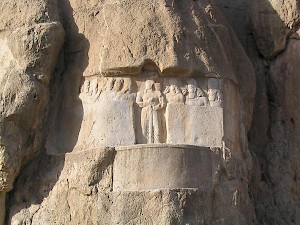Naqš-e Rustam, First (Audience) Relief of Bahram II
Q70786987Naqš-e Rustam: archaeological site in Fars (Iran), best known for its Achaemenid tombs and rock reliefs made in the Sasanian age.
First Relief of Bahram II

The Iranian king Bahram II (276-293) was not the strongest ruler of the Sasanian dynasty. Having lost a war against the Roman emperor Carus, he accepted the loss of Armenia and Mesopotamia; he had some difficulty in suppressing a revolt by his brother Hormizd; and he lost power to the Zoroastrian high priest Kartir. Still, Bahram II left no less than ten rock reliefs, three of them in Naqš-e Rustam.
The first of these shows an audience. Bahram's hands rest on his giant sword, showing that he is the man in charge of the kingdom. From the right, three imperial grandees show their devotion to the king. On the left, three people with diadems look at Bahram, together with two others, among whom we can discern the high priest Kartir. (He can be recognized from his badge.)
The three diademed people are almost certainly identical to Bahram's relatives Bahram I (r.273-276), Shapur I (r.241-272), and Ardašir I (r.224-241), the founder of the Sasanian dynasty. Probably, Bahram II needed to show himself with his ancestors, and with his sword so prominently displayed, because his position was hardly secure at all. This may also be the reason why he ordered this relief to be cut into the rock close to the Investiture Relief of Ardašir.
This relief was cut into the rock over an older, Elamite relief.
Literature
Louis Vanden Berghe, Reliefs rupestres de l' Iran ancien (1983 Brussels), #63.



